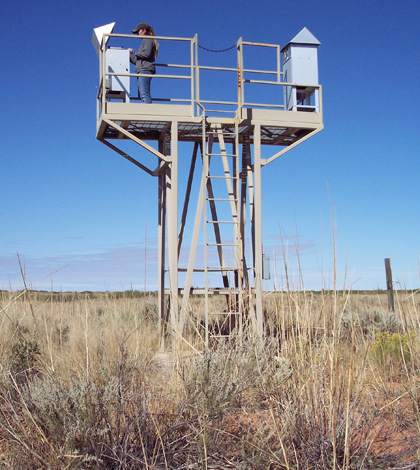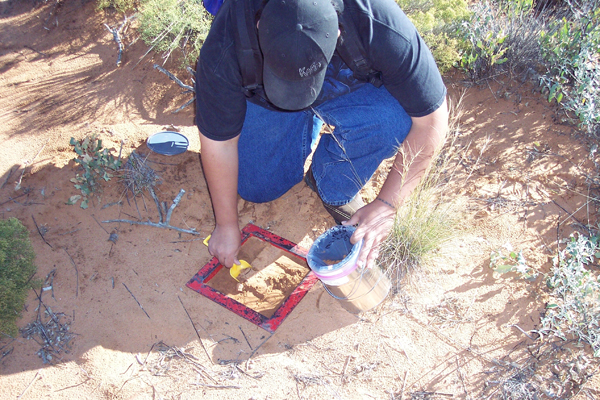Scientists ensure radioactive material in Waste Isolation Pilot Plant stays there

High-volume ambient air sampling at the Waste Isolation Pilot Plant (Credit: Russell Hardy/CEMRC)
Hundreds of millions of years ago, an ancient sea covered parts of the western U.S. Reaching all the way to present-day Kansas, its salty waters formed what is today the Permian Basin, a region rich in oil and natural gas. As the seawater receded, massive beds of salt were left behind that still support mines in the area.
The beds – now deep underground – are perfect for storing radioactive waste.
“We’re taking drums of radioactive material currently being stored on concrete pads and moving it 2,150 feet underground,” said Russell Hardy, director of New Mexico State University’s Carlsbad Environmental Monitoring and Research Center that monitors around the Waste Isolation Pilot Plant, the world’s only deep geological repository for defense-related transuranic waste. “They’re placed in rooms mined from the ancient salt beds, which will encapsulate them over time.”
There are routine checks on soil, air and water quality around the plant to make sure “what goes down there stays down there,” as Hardy says.
The salty earth around the facility is sampled biannually from two locations (16 samples in total). They’re looking for cesium, plutonium and strontium, according to Punam Thakur, head of the radiochemistry program at the plant. Each soil sample is passed through a gamma spectrometer to make sure radionuclide levels are low.
For the air, high-volume samplers track aerosols in the ambient air near the site, along with low-volume samplers that continuously collect air from within the repository year-round, says Thakur. Low-volume filters are retrieved every day. Aerosol filters are taken in every two to three weeks. Each is evaluated for the same target elements. Though the primary concern is a radioactive element in the air, concentrations of particulate matter are monitored as well.
The team also keeps tabs on three nearby lakes, but doesn’t monitor them nearly as often. “We take a boat, go out once every two years and take samples of water a few feet below the surface as well as from the lake bottoms,” said Hardy. But sediment sampling is more important because radioactive material will settle in the lakebed or surrounding soil.

Soil sampling around the Waste Isolation Pilot Plant (Credit: Russell Hardy/CEMRC)
“Once you detonate a nuclear device, the fallout will fall onto the ground,” said Thakur. “Most of the time, it winds up deep in the sediment or soil.”
Almost all plutonium that has been introduced into the atmosphere can be found in the surface soil. Radioactive materials bind with the soil and remain there until disturbed by the wind, rain or some other driver of erosion.
The plant has been operational for 14 years, and scientists have yet to see any evidence of a release. But that’s not to say the team hasn’t seen some blips on the radar.
“In those situations, we collect the results and get them to the public in 24 hours. The research is done in eight hours and then we get a report out in 10 hours. These are tedious procedures. They can sometimes take a week in normal times,” said Thakur.
Since every release of plutonium has a unique signature, it’s possible to know exactly where it came from. Everything they’ve seen has come from global fallout, including effects from the 2011 meltdown at Japan’s Fukushima Daiichi nuclear plant.
“One of our surprises after Fukushima was that it only took three days to travel across the ocean,” said Hardy.
Top image: High-volume ambient air sampling at the Waste Isolation Pilot Plant (Credit: Russell Hardy/CEMRC)





0 comments